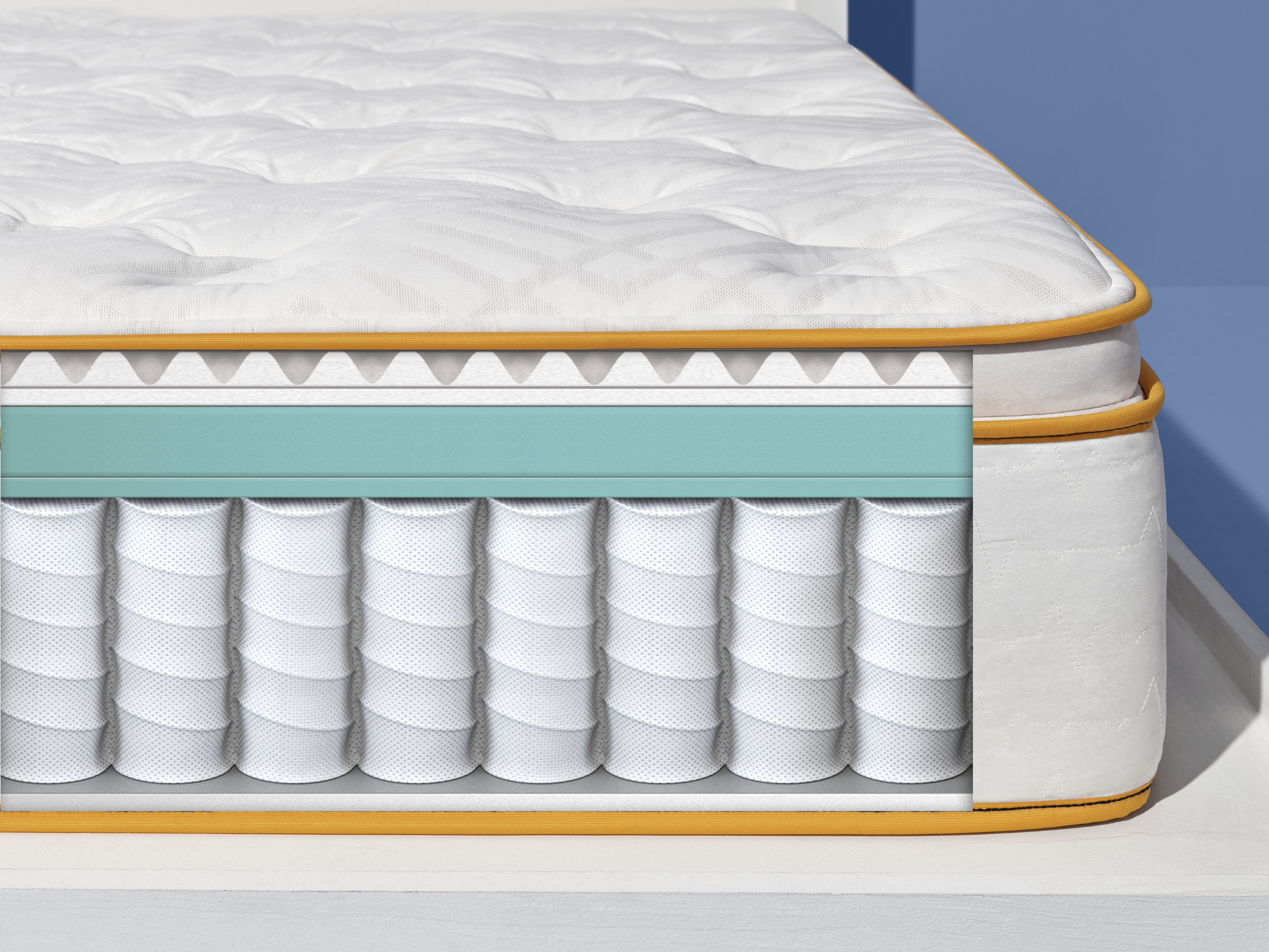Sleep has evolved from merely the last routine of the night, into the most important part of the day. Now, more than ever, sleep wellness is considered vital for living a healthy, functional lifestyle. But finding the ideal sleep is easier said than done, especially with the growing number of mattress types filling niche markets in the industry.
As a result, shoppers are asking themselves even more questions when it comes to buying a mattress. Which comfort level am I? Which mattress is best for my sleep position? What size mattress works for my body type?
To help you get the sleep you deserve, we’ve come up with this mattress buying guide to help put those questions to rest. Follow along!
Mattress Type
So, where should you begin when it comes to selecting a new mattress? While it might seem obvious to explore which comfort level suits you first, we suggest beginning with identifying which mattress type is best for your sleep routine. That’s because regardless of brand or model, buyers can count on each mattress type to be made of consistently similar materials, whereas comfort levels may vary between brands.
So, let’s explore!
Innerspring Mattresses
Chances are, you’re most familiar with the innerspring mattress. While that may be because it’s what your parents grew up with, it could also be because the innerspring mattresses continue to be the most popular mattress style to date. In an age that’s booming with new sleep wellness technology such as memory foam or gel support, it would seem the mechanical support of coils have gone obsolete — but that’s hardly the case.

For one, their familiarity has granted some trust from buyers compared to newer mattress models that buyers haven’t grown up with. Secondly, innerspring mattresses are pretty durable, thanks to a strong foundation of coils at the base. But perhaps most of all, innerspring mattresses are the most affordable option on the market.
Still, while coil mattresses are readily available, due to the construction, ultra-plush options are less common, and may not be the same comfort level of an ultra-plush memory foam mattress.
Memory Foam Mattresses

Using viscoelastic polyurethane foam instead of metal springs has made memory foam mattresses a preferred sleep choice for users seeking pressure relief. While springs work by resisting weight and pressure, the coils push on the body, creating pressure points. On the other hand, memory foam provides evenly distributed support that contours to the body.
The major drawback with memory foam is that the material can trap heat and create warm sleep environments. Luckily, new advancements, such as gel-infused foam, help dissipate heat for cooler sleep.
Additionally, the plush composition of memory foam means there are far fewer firm and extra-firm options available, which are ideal for back and stomach sleepers.
Hybrid Mattresses

If coil mattresses are the mattress of our parents’ generation, then hybrid mattresses are the newer generation’s mattress type. That’s because hybrid mattresses fuse the sturdy support of innerspring coils at the base with soft padding above, often made of memory foam, latex, or a combination of both.
As a result, hybrid mattresses provide traditional bounce with body-shaping comfort. In most cases, this dual-support is a safe fit for most sleepers, but sleepers who are extremely sensitive to motion transfer might prefer the superior motion dampening performance of memory foam.
Mattress Sizes
Knowing which mattress size to purchase comes down two to main factors: the size of a bedroom and body type. Here’s what you should know.
Twin vs. Twin XL
Did you know a twin XL mattress is the same length as a queen and king mattress, but not as a regular twin mattress? While the standard width for both twin and twin XL mattresses is 39 inches, the latter is five inches longer at 80 inches compared to 75 inches.
When should you choose a twin or twin XL mattress?
Whether you currently live with a growing member of the family, or are expecting a spurt soon, a twin XL mattress can accommodate your little sleeper throughout the process until he or she is ready to upgrade to a full mattress.
While it’s perfectly okay to go from a regular twin to full mattress, opting for twin XL can help delay the need to replace, which can potentially save buyers some extra cash and time.
Full
While a full-size mattress is the same length as a regular twin, it is roomier at 16 inches wider. This provides an ideal amount of room for a single person, and a cozy sleep setting for two, while it’s generally not recommended if you also plan to include a child or pet.
When should you choose a full mattress?
As mentioned, a full-size mattress is the next size up for adolescents entering into young adulthood, but with the ability to accommodate two adults, a full mattress can also be an affordable option for partners.

Queen
At 60 inches wide (that’s five full feet), queen mattresses provide room for two to comfortably sleep, and at 80 inches in length, there’s plenty of leg room, too. At these dimensions, queen mattresses fit most standard-size rooms, meaning shoppers can enjoy maximum sleep space that doesn’t take up the entire room, often at an affordable price. No wonder, queen-size mattresses are the most commonly sold mattress size on the market.
When should you choose a queen mattress?
Whether you want extra space to sprawl for yourself, or plenty of room to cuddle, a queen mattress is a viable option. While full is often considered the most affordable mattress option in correlation to size and price, for a little extra, sleepers can enjoy a lot more sleep space all around.
King vs. California King
At 76 inches in width, king mattresses are the widest commercial mattress size on the market. In fact, a king mattress can easily accommodate two adults along with a child (or fur baby). On the other hand, California king mattresses are the longest mattress size available at 84 inches (seven feet!).

When should you choose a king or California king mattress?
In both cases, it’s imperative that the size of a room can practically lodge a king or California king mattress. The extra space sounds enticing, but if it comes at the cost of not being able to open storage drawers, or having to scuttle around the bed, the next size down is recommended.
Additionally, the bedroom door is also important to remember. Some homes may have smaller doors, which can make moving a king/Cal king mattress through difficult, if not impossible.
If this is the case, consider purchasing a split mattress. It will have the same dimensions of the respective mattress size selected, just split between two separate mattresses, allowing for easier delivery.
Mattress size recap:
| Twin | Twin XL | Full | Queen | King | California King | |
|---|---|---|---|---|---|---|
| Dimensions
(W x L) | 39” x 75” | 39” x 80” | 54” x 75” | 60” x 80” | 76” x 80” | 72” x 84” |
Mattress Comfort
Typically, a mattress’ comfort level correlates directly to the firmness. Often, this can be described on a scale from one to 10, but we’ve found that can vary from one brand to the next. Instead, when researching mattress comfort level, stick to these key terms.
Shop for an Extra-Firm Mattress if:
If you or a partner sleep are exclusively back-sleepers, then the stable support of an extra-firm mattress (a.k.a., very-firm) should be the ideal mattress comfort for you. That’s because the sturdy surface is ideal for keeping the lumbar aligned with the rest of the body, which is better for the back.
However, that very same firmness can cause the spine, hip, neck, and shoulders to fall out of alignment once the sleep position goes from back to the side.

Shop for a Firm Mattress if:
As with extra-firm mattresses, firm mattresses are also great for supporting the back on a flat plane. However, since they are a little more plush, firm mattresses are also great for stomach-sleepers, whereas sleeping on the stomach is not recommended on a very-firm mattress. While this comfort level provides a little more versatility, it is still considered too firm to properly support the posture of side-sleepers.
Shop for a Medium Mattress if:
The good news is mattresses with a medium comfort level appeal to a large range of sleepers, from back to stomach, to side-sleepers, too. These mattresses also provide more give than a firm mattress, and help to properly align the shoulders, back, pelvis, and hips.
Shop for a Plush Mattress if:
Side-sleepers benefit the most from a soft comfort level since the mattress envelopes the body rather than pushing it away. While the plush support may be good for some back-snoozers, many experts suggest avoiding a plush mattress if you sleep on your stomach since it could lead to extensive arching in the back.
Shop for an Ultra-Plush Mattress if:
At the softest comfort level available, the enhance pressure relief of an ultra-plush mattress is a dream for side-sleepers — but not so dreamy for users who sleep on their back or stomach.

Sweet Dreams Available Near You
Whether you choose to buy a mattress online, or shop in-store, Spencer’s TV & Appliance is Phoenix-area’s trusted provider of mattress for every sleep routine, from six mattress sizes and four mattress types in comfort levels from ultra-plush to extra-firm. Shop today!